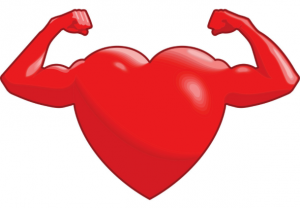
With Valentine’s Day just around the corner, the topic of this month is the heart!
Bridging the gap between literal and metaphorical, did you know that Broken Heart Syndrome is a real physical condition!? 💔
It is also known as Takotsubo (Tah-kah-tsu-bo) Cardiomyopathy or Stress Cardiomyopathy. It involves sudden but temporary weakening of the heart muscle and is triggered by emotional or physical stress, including: the death of a loved one, a relationship break-up, illness, and surgery. Fortunately, the condition usually reverses itself in a few days or weeks.
Heart Disease
Heart Disease can include:
- Cardiovascular Disease, often blockages in the blood vessels leading to lack of blood and oxygen to the muscles (including heart muscle), Coronary Heart Disease, Stroke, cardiomyopathy, heart attacks.
- Arrhythmias
- Valvular Heart Disease
- Heart Failure
!Cardiovascular Disease is the leading single cause of Death in Australia!
In 2017, Heart Disease was responsible for a death in Australia every 28 minutes
Specialised Health vs The Heart
Specialised Health strives to provide superior Exercise Physiology services, delivering the best care to customers, claimants and their rehab team. You wouldn’t usually consider heart health for a knee injury suffered in the workplace, or even whiplash after a car accident. However, as Exercise Physiologists, conditioning people back to work and life through physical activity, we need to be aware of any pre-existing conditions or risk factors (such as cardiovascular disease!). Plus, increased fitness has been associated with: decreased pain tolerance and improved mood symptoms (side effects we often see from disruptive injuries).
We are also referred customers under Income Protection, specifically with cardiac conditions. With the heart being so imperative to keeping us alive, when something goes wrong it can be quite scary. So, other than the obvious improvements in physical fitness the main feedback we get back from our claimants is about the relief and gratification they experience with the increased confidence they have in returning to their normal activities after our program. (And that’s why we do what we do!)
In addition to aerobic fitness and cardiovascular health we are learning more and more about the relationship between the heart and the nervous system through Heart Rate Variability. Make sure you’re keeping an eye on the Specialised Health spaces online to keep up to date with our new initiatives.
Now, the question that everyone wants to ask… What’s all this business with HIIT?
HIIT (High Intensity Interval Training), has been around for decades however has increased in popularity lately, assumedly due to it being “time-efficient,” fitting in with our busy lives and desire for quick results. Physiological adaptations (cardiovascular, metabolism, blood profile, oxygen utilisation) occur, with ½- ⅓ of the time commitment compared to lower intensity, continuous exercise.
HITT is an exercise protocol that includes:
- 30 seconds – several minutes of high intensity exercise (approx 85% Max Heart Rate)
- Rest for 1-5 minutes of either no or low intensity
- Repeated 4-6 times
However!
Due to the higher intensity and potential of insufficient rest periods, there is a higher injury risk with HIIT, especially if you are new to exercise. It is not safe for everyone, particularly those with hypertension / high blood pressure. (This website provides some good recommendations to decrease injury risk: http://fellrnr.com/wiki/Safe_Speedwork)
Always check with your doctor before starting a new exercise program, particularly if you have any health conditions or haven’t exercised for a while.
Any exercise is better than no exercise!
Depending on what condition you are in physically and behaviourally, it may be worth starting at lower intensities and building your habit and confidence in exercise.
I don’t always agree with “articles” I find online, but this one I like! 5 Common Myths about HIIT. All that said, research clearly supports the effectiveness and superiority of HIIT! – Just be smart about it!
Fun Facts About the Heart
- The first heart beat sound we hear is the closure of the AV valve (which happens after atrial contraction)
- The second heart beat sound we hear is the closure of the Semilunar valves (valves between the ventricles and arteries).
- The average heart weighs between 200-400 grams
- By the end of the average life, the heart has beaten more than 350 billion times
- At rest, 15-20% of blood goes to skeletal muscle; during exercise, this amount increases to 80-85%.
- Variety of colours in your diet provides variety in nutrients. Foods containing cocoa improve blood vessel health (endothelial function) and blood pressure! (That’s associated with very high dark chocolate, and excess is not recommended!)
- Exercise has been shown to be more important than smoking cessation! I.e. A fit smoker is healthier than a sedentary individual (Though an active non-smoker likely has the best future obviously…!!)
Find tips to manage or decrease risk of heart disease here.
Recognise a Heart Attack here
Support to decrease risk:
Yours in Health,
Biara Webster
Exercise Physiologist

References
- https://www.history.com/this-day-in-history/st-valentine-beheaded
- https://www.mayoclinic.org/diseases-conditions/broken-heart-syndrome/symptoms-causes/syc-20354617
- Australian Bureau of Statistics 2018, Causes of Death 2017, ABS cat. no. 3303.0,September http://www.abs.gov.au/ausstats/abs@.nsf/Lookup/by%20Subject/3303.0~2017~Main%20Features~Australia’s%20leading%20caues%20of%20death,%202017~2
- Aerobic Exercise Improve Pain Perception and Mood? A Review of the Evidence Related to Healthy and Chronic Pain Subjects Hoffman, M.D. & Hoffman, D.R. Curr Pain Headache Rep (2007) 11: 93. https://doi.org/10.1007/s11916-007-0004-z
- Exercise and the Cardiovascular System Clinical Science and Cardiovascular Outcomes Circ Res. 2015;117:207-219. DOI: 10.1161/CIRCRESAHA.117.305205)
- https://fitness.mercola.com/sites/fitness/archive/2018/11/02/sitting-is-the-new-smoking.aspx
- Cocoa Intake, Blood Pressure and Cardiovascular Mortality https://jamanetwork.com/journals/jamainternalmedicine/fullarticle/409867 Arch Intern Med. 2006;166(4):411-417. doi:10.1001/archinte.166.4.411